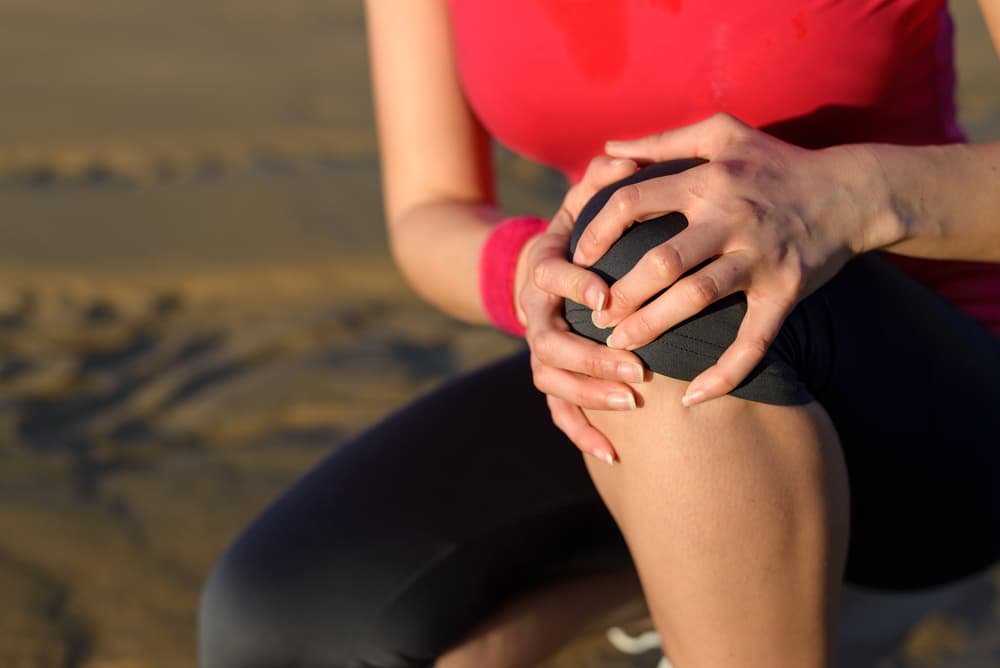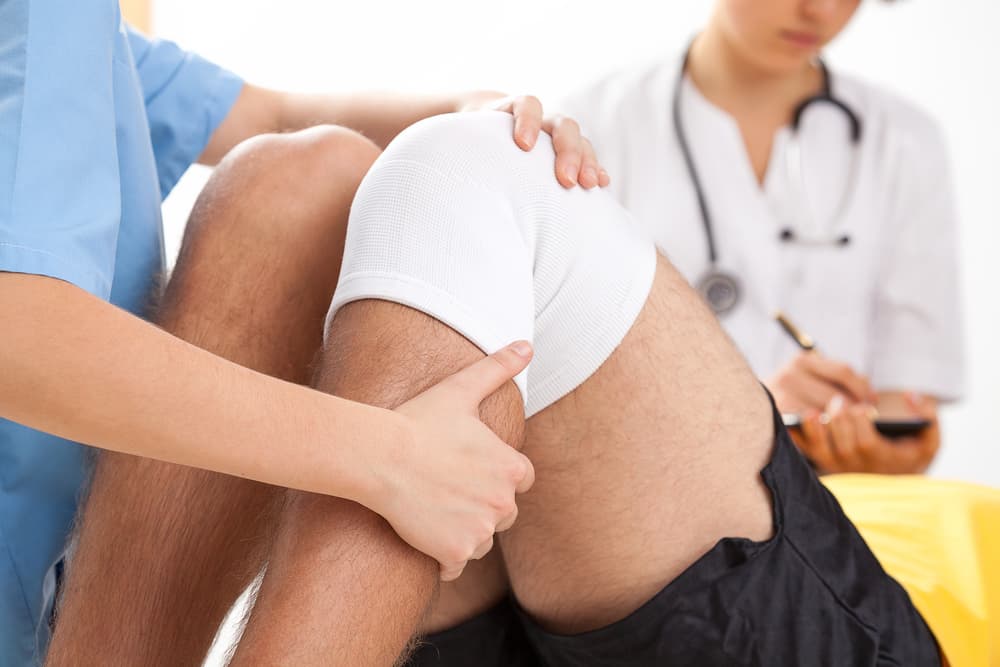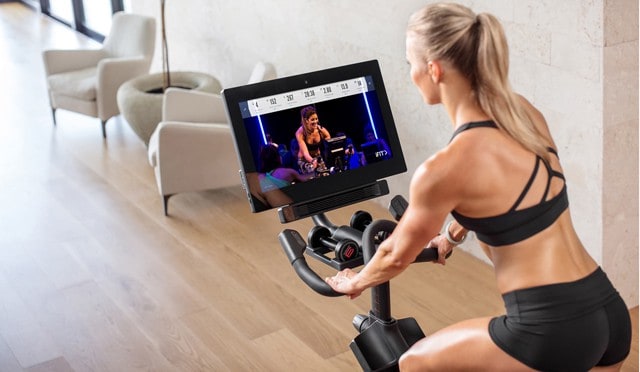If you have ever had, or currently have, a knee injury or surgery then you may be wondering whether an exercise bike/stationary bike will be beneficial in aiding your recovery.
If you are planning to use a stationary bike as part of your rehabilitation then you may also be wondering when/ how to start, and which type of bike to use.
Advantages of Using an Exercise Bike After Injury
Using an exercise bike has many benefits for the entire body. Not only does it improve cardiovascular health and aerobic capacity, it also improves and supports oxygen rich blood circulation and provides a much needed endorphin boost.
The main advantages of cycling on an exercise bike after a knee injury are increased range of motion and low load rehabilitation with increased stability vs outdoor cycling, as well as decreased perception of pain – possibly due to the body’s natural endorphin response and reduced fear of movement (kinesiophobia).
This was evidenced in a ground-breaking study by Hoffman, M. (2000)[1] in which participants with low back pain reported significantly less pain after thirty minutes of moderate intensity cycling on an exercise bike.

How Soon After Injury Can I Start?
A common question many keen cyclists ask me after knee injury is when can I start cycling again? This really depends on the type and extent of injury, as well as the stage of soft tissue healing.
Take for example a meniscal tear versus a meniscal tear + grade three collateral ligament sprain. The latter involves a higher degree of soft tissue damage that would take longer to calm down in terms of swelling, pain and function.
This is why it is important you see a qualified healthcare professional who can guide you appropriately.

Some common knee injuries I see in practice including patella bursitis/ tendinopathy, quadriceps or calf strains, I recommend waiting until the initial inflammation begins to settle down.
This is usually 4-6 days, in which time patients can focus on pain relief, icing, and elevating with relative rest throughout the day. The key is to focus less on a specific timeframe and more so on how the knee responds, as we are all unique and therefore our bodies react differently.
Once started, I would recommend using little to no resistance for a short period of time and gradually building up over the next few weeks whilst closely monitoring how the knee reacts after each session.
For tendon issues I might reduce the peak angle of flexion by raising the seat or utilizing a recumbent bike with a more reclined sitting posture.
For the less common, more severe knee injuries that do not immediately require surgery (i.e. Isolated ACL sprains, meniscal tears) it is slightly slower and more conservative.
The key things I am often looking for are a reduction in pain and swelling, enough to be able to bend the knee 100-110 degrees and achieve a full revolution on the pedals, as well as improvement of any local muscle inhibition.
As always, I recommend anyone suspecting a serious knee injury see his or her local physician for a comprehensive review and treatment plan before starting with any type of exercise.

How Soon After Surgery Can I Start?
Surgical rehabilitation of knee injuries is much more protocol driven and therefore a lot more strict in terms of progression.
A short overview of the most common knee surgeries:
1. Meniscectomy/Meniscal Repair
If proceeding with the more straightforward meniscectomy, in which the offending piece of cartilage is removed, it is often possible to get patients cycling within 2 weeks of surgery. This helps to improve local circulation and knee mobility early on in the rehabilitation.
A meniscal repair however is much more restrictive in the sense that patients are often in a brace for 4-6 weeks depending on the size of the repair.
Once out of the brace it is often then possible, and extremely beneficial, to start on an exercise bike with little to no resistance, under the guidance of an appropriately trained Physiotherapist.
2. ACL Reconstruction+/-Meniscus
After 4 weeks, it is usually possible to initiate the stationary bike as an excellent way to accelerate the healing process and knee mobility. At this point a slow pace and very light resistance is the way to proceed, gradually building up as we go along.
An ACL reconstruction can often also incorporate a meniscal tear due to the mechanism of injury. When this happens the post-operative protocol first follows that of the meniscal repair, which again depending on the size of the tear will involve being in a range of motion restricted brace for 4-6 weeks. Only once the brace is weaned away is it possible to cycle.
3. Total/Partial Knee Replacement
Following a total knee replacement, the initial goals are focused on reducing pain and swelling, as well as increasing range of motion and quadriceps control.
Goals for range of motion aim to achieve 90 degrees flexion by 6 weeks. In reality, I often find most patients achieve at least this by week 4. Once able to flex the knee around 100-110 degrees it is then possible to start using an exercise bike.
The Three Main Types of Stationary Bike
There are various types of stationary bike available, each with their own advantages and disadvantages. It is therefore important to make sure that you choose the right machine for your requirements, when purchasing for personal use.
The three most common types of exercise bikes:
Recumbent
 Offering a more reclined posture a recumbent bike sits the user in a leaned back position. With handles, both in front and to the side it offers a more leisurely workout than its comparatives.
Offering a more reclined posture a recumbent bike sits the user in a leaned back position. With handles, both in front and to the side it offers a more leisurely workout than its comparatives.
The reclined posture of this type of bike means that there is less load going through the joints, whilst the backrest provides more stability and support for the spine.
This bike could be especially useful for those with back issues or limited range of motion in the knees due to conditions such as osteoarthritis.
Upright
 Most closely replicating a regular bike, the stationary upright bike is often the type found in most gyms. It is similar to a regular bike in the sense that the crank (the handle to which the pedals are attached) sits directly below the seat.
Most closely replicating a regular bike, the stationary upright bike is often the type found in most gyms. It is similar to a regular bike in the sense that the crank (the handle to which the pedals are attached) sits directly below the seat.
The seat itself is adjustable usually up and down, as well as forwards and backwards. Starting with the seat higher reduces the angle of flexion produced at the knee to a point, which can be helpful when just starting to cycle after a knee injury or surgery.
Upright exercise bikes are great for working the gluteal, thigh, and calf muscles. They also benefit hip, knee and ankle range of motion and mobility all whilst providing a low load – low impact workout.
Spinner
 Spin bikes are the type of bike you often see in an aerobic studio at a gym. They usually use a large disc called a flywheel at the front to deliver resistance to your pedalling power.
Spin bikes are the type of bike you often see in an aerobic studio at a gym. They usually use a large disc called a flywheel at the front to deliver resistance to your pedalling power.
Alternatives utilise fans or magnets. The advantages of this bike are that they deliver a great cardiovascular workout, can be used for strength training in a standing up position, and allow you to work multiple muscle groups in one session.
How to Correctly Set Up and Use Stationary Bike?
The most important thing when you use an exercise bike is comfort. You can also make small changes as mentioned previously in order to reduce or increase the amount of hip, knee and ankle movement required to pedal. However, as a general guide refer to below:
- Check seat height – stand next to the bike and set the top of the saddle to align with the bony outcrop on the side of your hip. You should have a slight knee bend with the pedal at the 6 o’clock position. Do not fully extend the knee.
- Set handlebar distance – Again comfort is key but as a rule, most people measure the distance from tip of the knee to the handle bar as elbow to end of a loose fist. You should have relaxed, slightly bent elbows while cycling.

My Recommendations for Purchasing a Stationary Bike for Personal Use
The key thing when purchasing your own bike for home use it to make sure you have thought through your specific needs. There are many brands with many different unique and quirky features to choose from. To cut through all the noise it is often best to consult with a health & wellbeing or fitness professional.
For a comprehensive review of our top recommended picks, visit the exercise bikes review page.
Reference
[1] Medical College of Wisconsin. “Exercise: a Natural Reliever for Chronic Low Back Pain.” Healthlink. 2000.
- Isometric vs Isotonic vs Isokinetic Exercises: Explained - 12 August 2022
- Is Pilates Better Than Weight Training? - 29 March 2022
- Can You Use A Massage Gun For Carpal Tunnel Syndrome? - 16 March 2022
